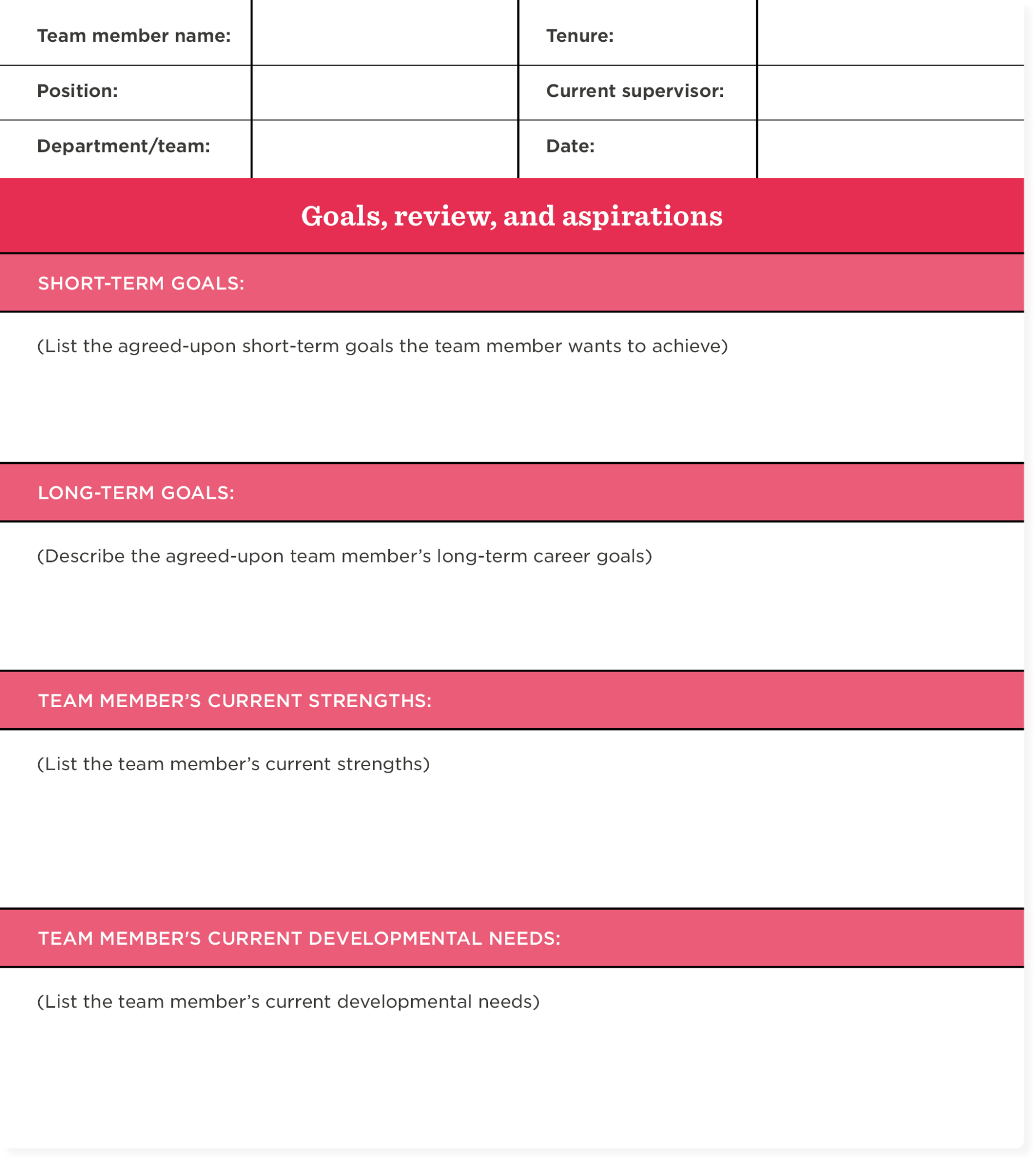In the world of HR, employee development is more than just a simple buzzword.
Being able to help your people grow in their roles and reach their full potential is essential to any HR professional’s role.
Proper development helps with a wide range of things, such as bolstering job satisfaction, enhancing employee retention, or even boosting productivity.
Well-designed employee development plans can be the bedrock of your team’s career growth. And in the long run, they can truly become the driving force behind your company’s success.
In this guide, we offer insights into creating an effective employee development plan, highlighting its importance, the process involved, and the steps needed to turn your plan into a reality. Plus, we’ll give you a customizable free employee development plan template to help kick-start your team’s growth paths.
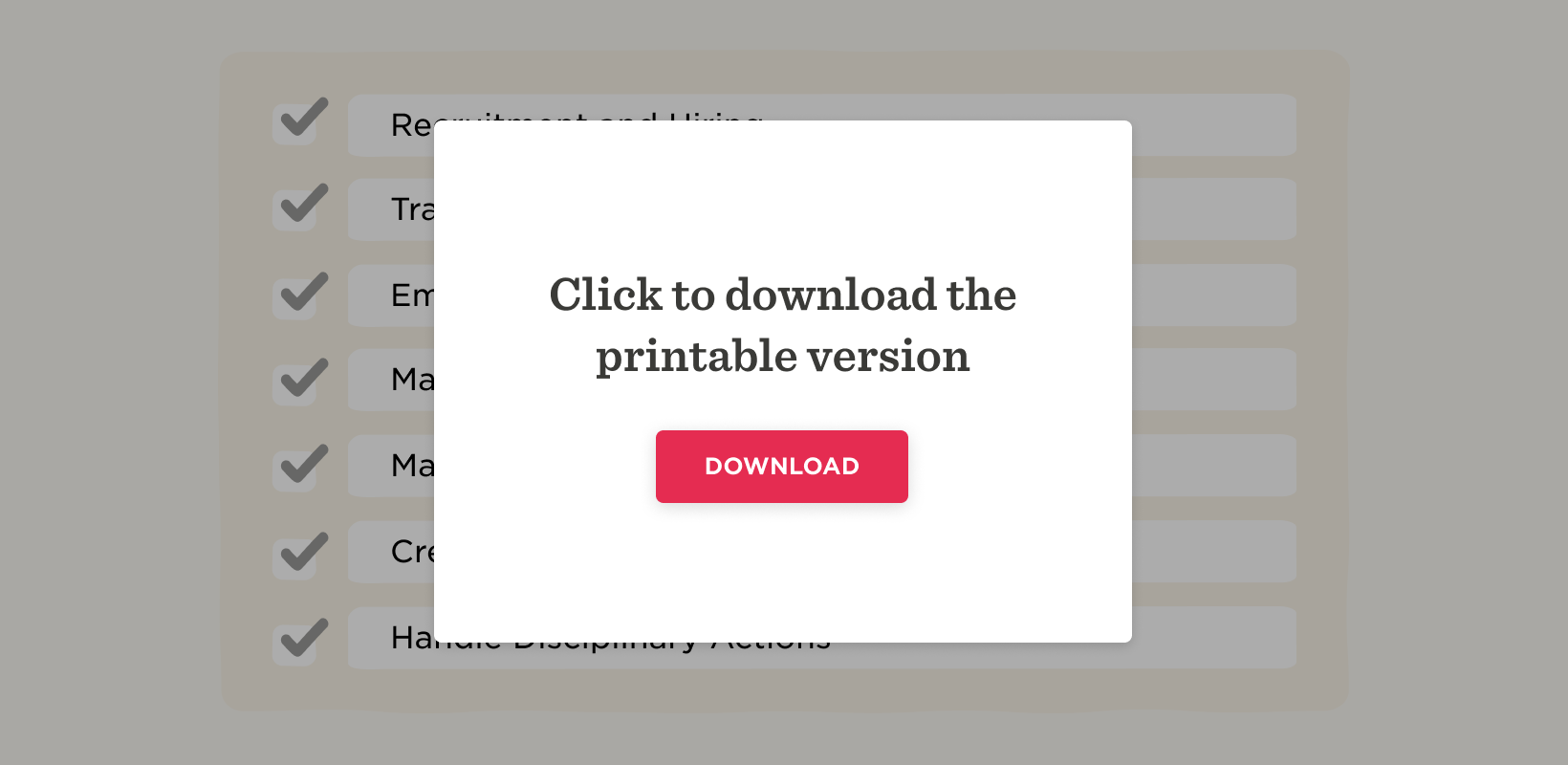
What is an employee development plan?
Think of an employee development plan as a strategic roadmap that’s tailored to help your people grow professionally within their roles.
The plan will outline each of your team member’s specific, personalized goals, the skills they need to develop, and clear steps to support both their personal and career development.
Essentially, employee development plans are a way to support the continuous growth of your people—helping to build the future success of your organization through well-rounded, multifaceted team members.
Key components of an employee development plan
There are a number of key elements that make up an employee development plan. A typical structure will go something like this:
- Personal information and role overview. A clear summary of the team member’s current role, their responsibilities, and any relevant personal details.
- Development objectives. A clear outline of the team member’s short and long-term professional goals, focusing on specific and measurable targets.
- Skills gap assessment. A thorough evaluation of the team member’s current skill set, highlighting areas for improvement.
- Action items and development activities. Specific actions or activities to bridge the skills gaps, including the “what” and the “how” of the development process.
- Timeline and milestones. A structured timeline with clear and specific deadlines and milestones.
- Resources and support. A list of available tools and resources to support employee development, such as budget for courses, access to mentors, or learning platforms.
Why is an employee development plan important?
An employee development plan, or EDP, is a strategic document outlining your team member’s career development.
EDPs are vital for several reasons:
- Skill development. They help identify the skills a team member needs to improve or enable them to reach their professional goals.
- Greater engagement. When a team member sees a clear pathway for their growth within the organization, it can lead to greater engagement.
- Succession planning. They help to shape team members for future leadership roles, allowing you to plan for the future.
- Increased retention. They can reduce turnover rates as team members are more likely to stay with an organization that invests in their future and development.
- Performance improvement. Consistent learning and development improve team members’ productivity and performance, contributing to the organization’s overall success.
How to create an employee development plan
Crafting an effective employee development plan requires a tailored approach that includes carefully evaluating your individual team members’ goals, strengths, and specific areas for improvement.
The process of creating and carrying out an EDP is a collaborative effort. It works best with the full involvement and commitment of team members, leaders, and management.
Here is a step-by-step guide to curating an effective employee development plan:
- Identify goals. The first step to any employee development plan is to establish several clear and achievable short- and long-term professional goals. You can align these goals with your company’s business objectives to help achieve true cohesion and ensure the team member’s progress contributes to the overall success of your organization.
- Assess current skill levels. The next step is performing a thorough skills audit to better understand team members’ current skill levels. This process can offer insights into what skills gaps team members need to bridge to enable them to reach their desired goals.
- Develop a series of actions. Once you’ve identified skills gaps, you can start to formulate specific actions to close these gaps. These actions can involve a wide range of development activities, such as on-the-job training, workshops, online courses, mentoring, or even job rotation or shadowing.
- Set a realistic timeline. Once your actions are in place, the next step is to set a realistic timeline outlining when the team member is expected to achieve each goal. A timeline provides a sense of direction and adds a hint of urgency, helping you and your team members manage time effectively and stay on track.
- Review and adapt. An effective employee development plan doesn’t stand still. It’s a fluid document that you regularly update and change. With this in mind, it’s a good idea to review and tweak each EDP regularly to align with team members’ progress and accommodate any changes in their roles, career ambitions, or the organization’s needs.

A practical employee development plan template
Creating an employee development plan from scratch can seem daunting. That’s why we’ve put together a template that can act as a framework for you to start building your own personalized development plans.
An employee development plan template gives you a robust structural framework for creating individualized plans for each team member. It can provide the spark of inspiration you need to develop programs that perfectly match both your team and organization.
Here’s our comprehensive template to help you get started:
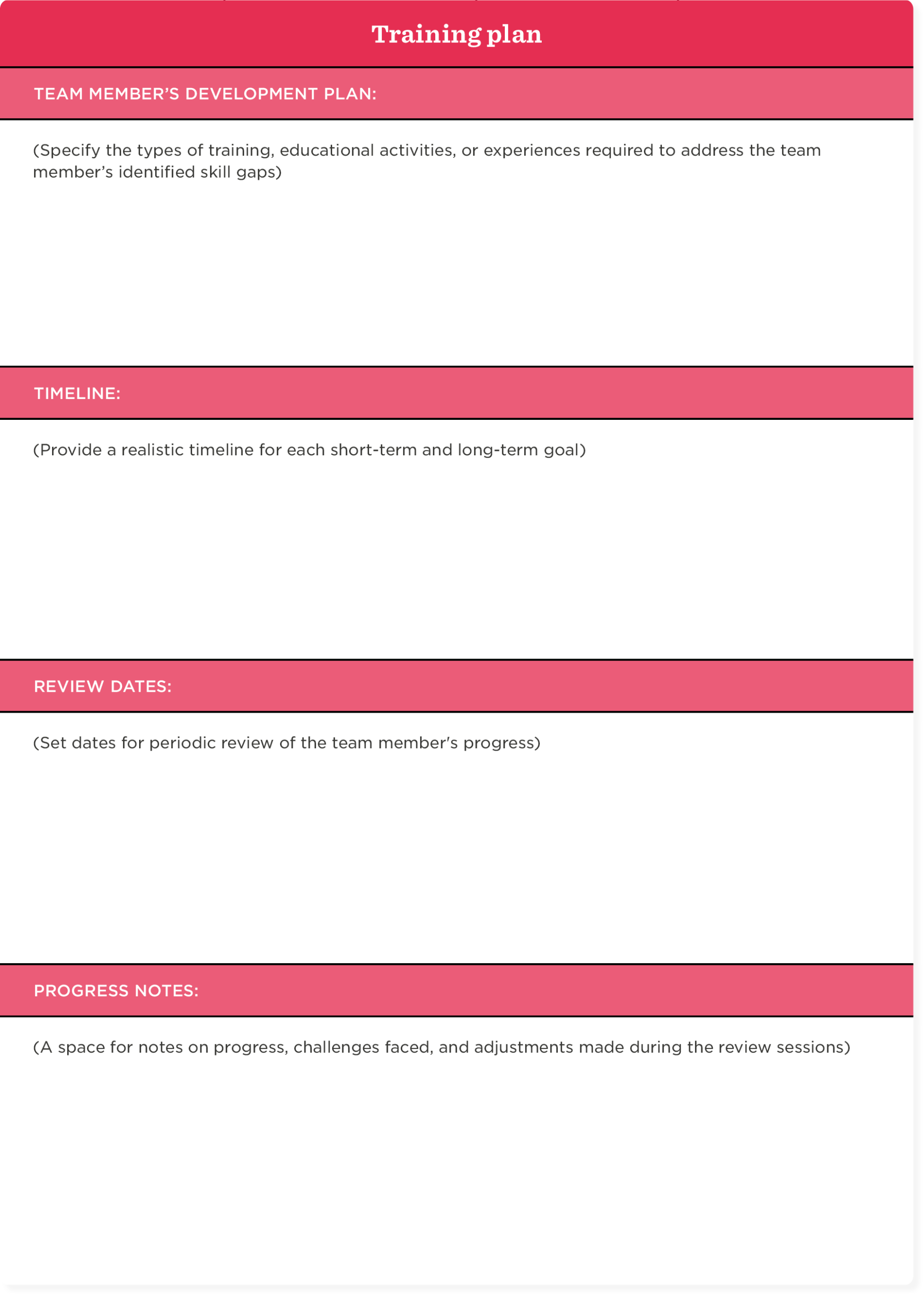
Customizing development plans for different employee roles
It’s important to remember that employee development plans aren’t one-size-fits-all. They work best when they’re tailored to each team member, right down to their individual personal and professional aspirations.
While the main skeleton of the plan can be the same or similar across the board, consider tailoring things such as:
- Requirements. Different roles demand different skills. So, reflecting on the unique requirements of each position will help you ensure that each person is upskilling for a specific role.
- Goals. Having personalized goals based on the individual’s role ensures that each team member is working towards meaningful objectives.
- Level of support. The level of mentorship, coaching, or training can vary according to the team member’s experience, role, and also preferences. Some people work best with a less “hands-on” approach for example, or a junior member may need stronger guidance while a senior professional might benefit from more of a strategic approach.
Future career paths. Consider tweaking EDPs based on the long-term aspirations of each team member and how their roles can evolve within your company—allowing people to see a tailored view of how they can grow and progress over time.
Examples of employee development plans
To give you a better understanding of the structure and content of an effective employee development plan, here are five hypothetical employee development plan examples of what a filled-out plan might look like:
Leadership development plan
Skills development plan
Foundational professional development plan
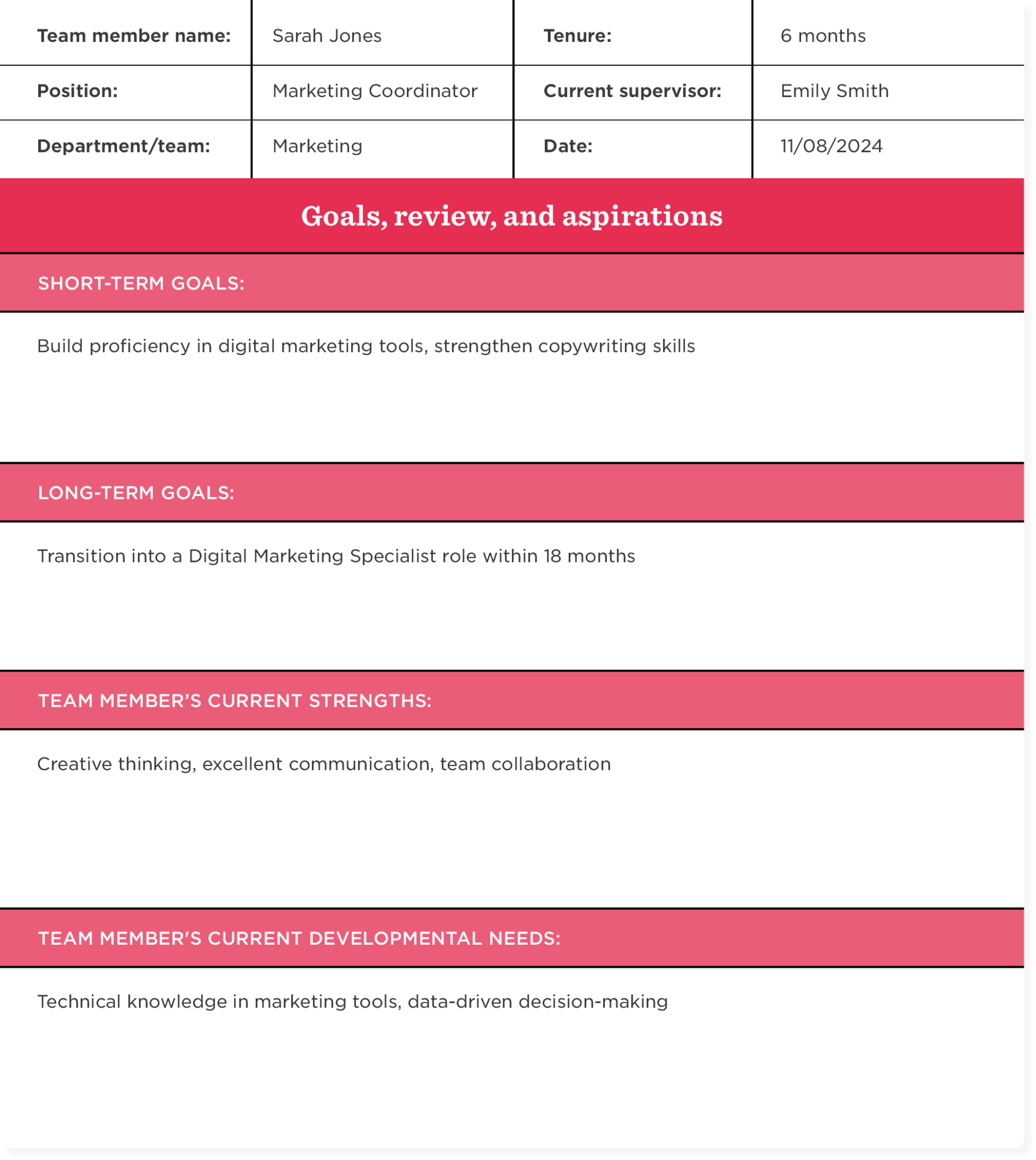
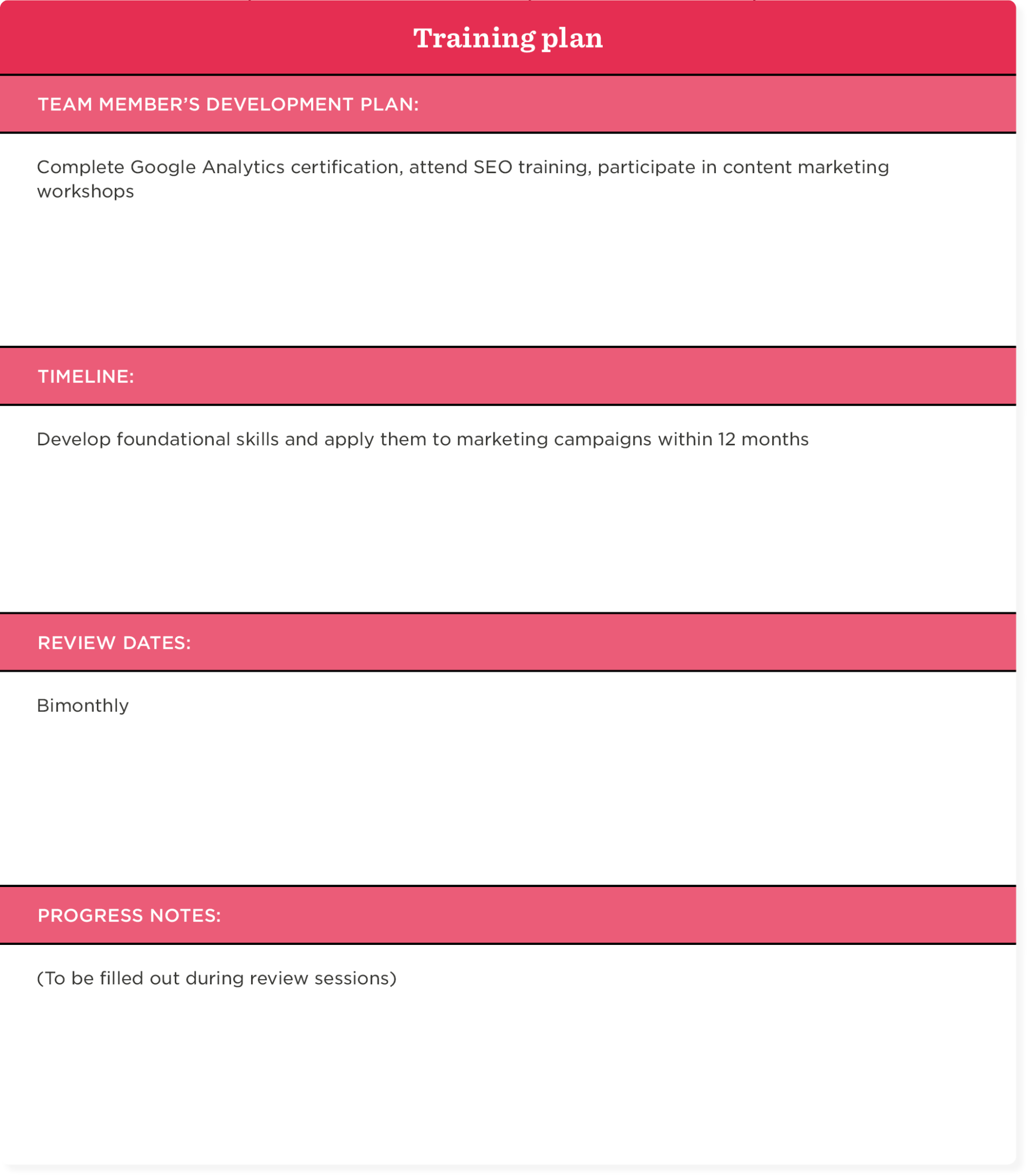
Career advancement plan
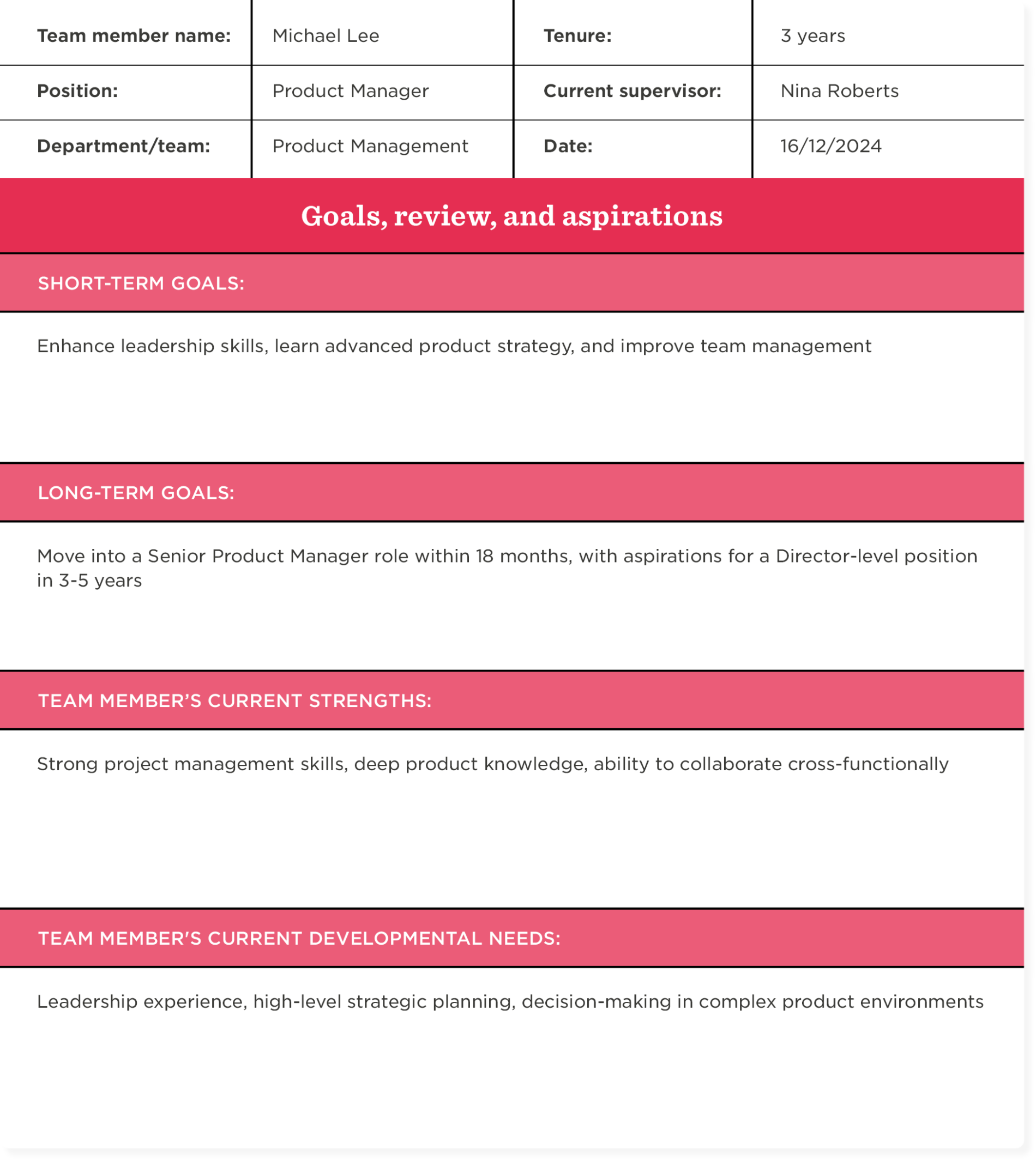
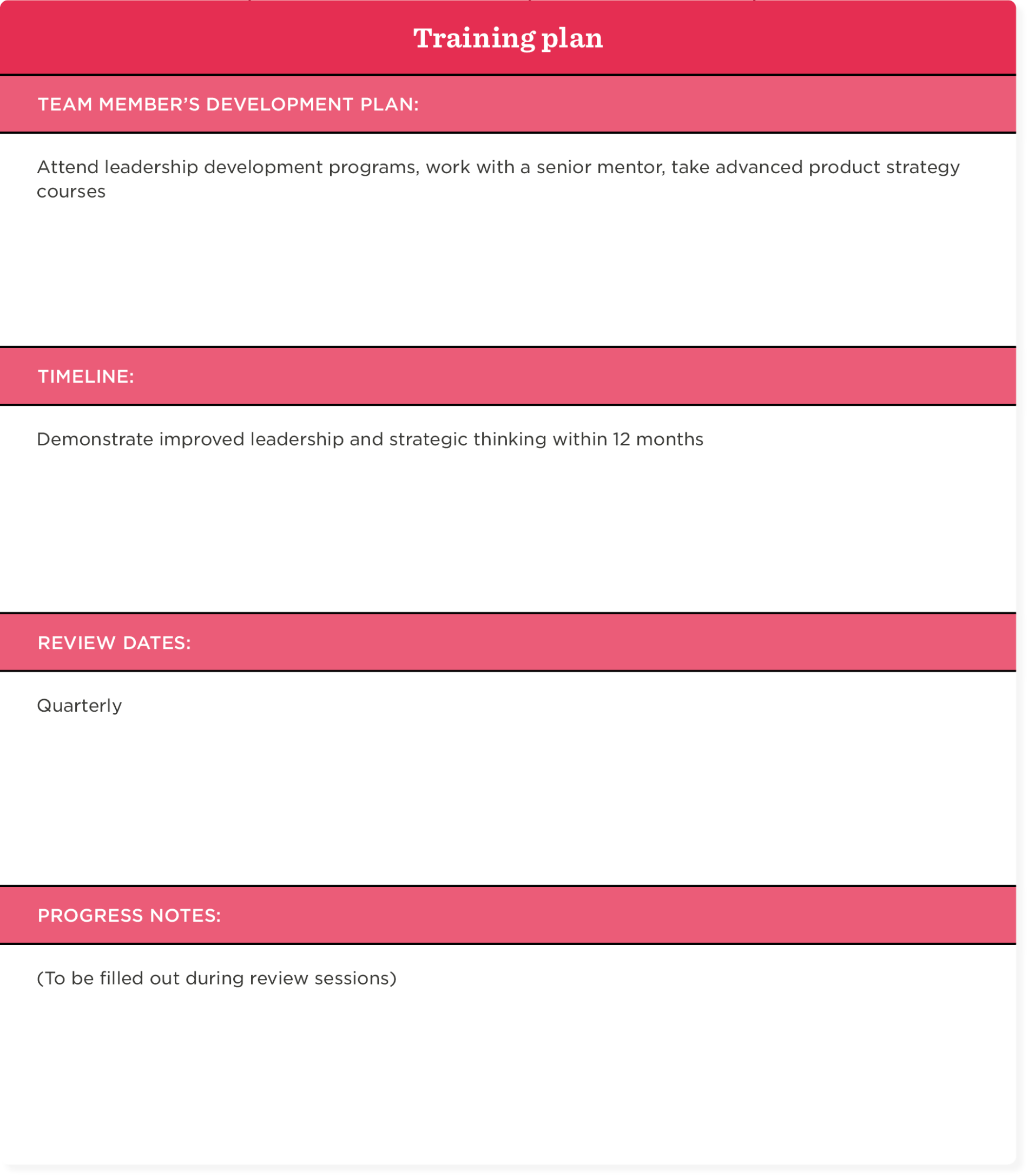
Performance-based development plan
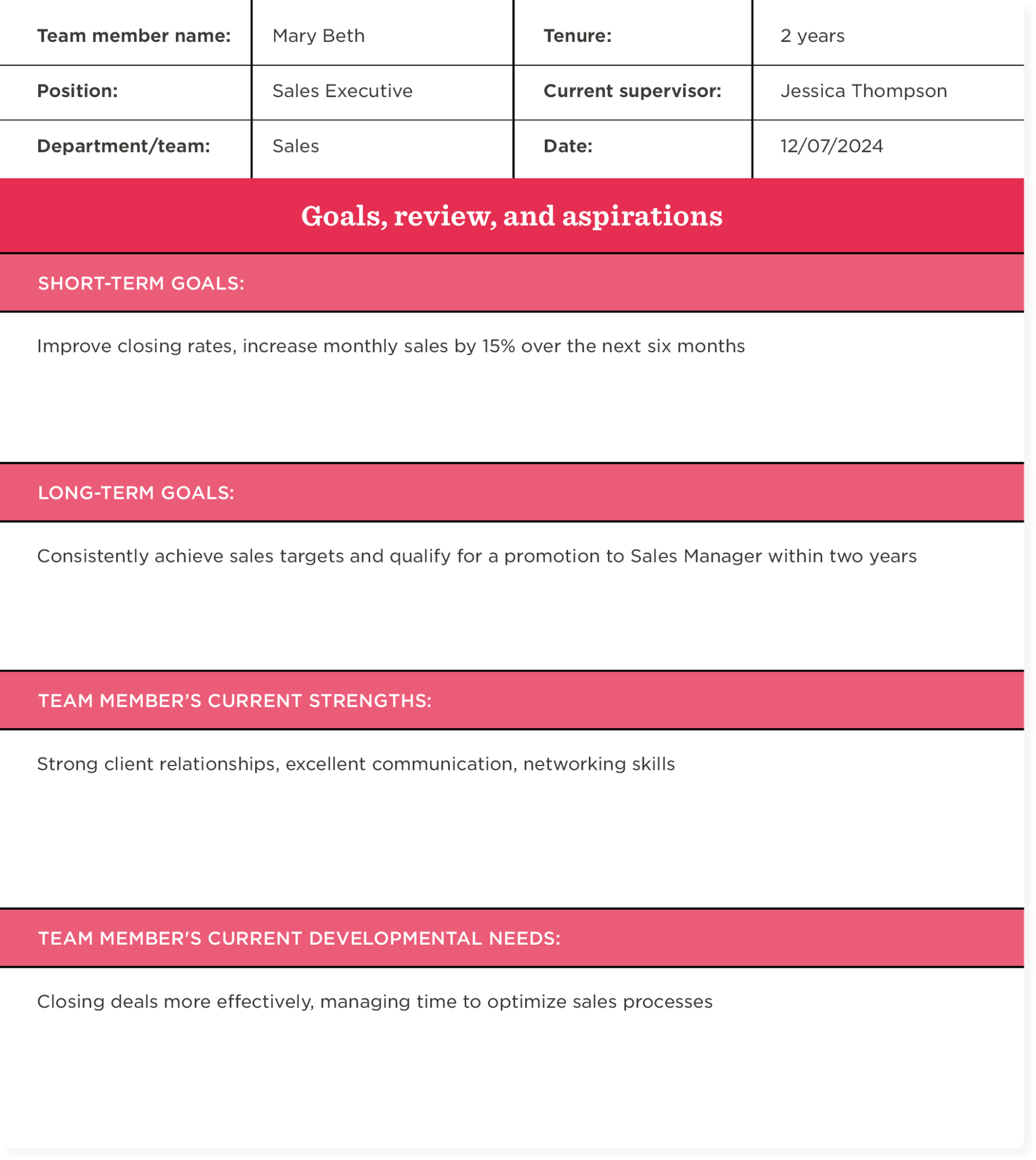
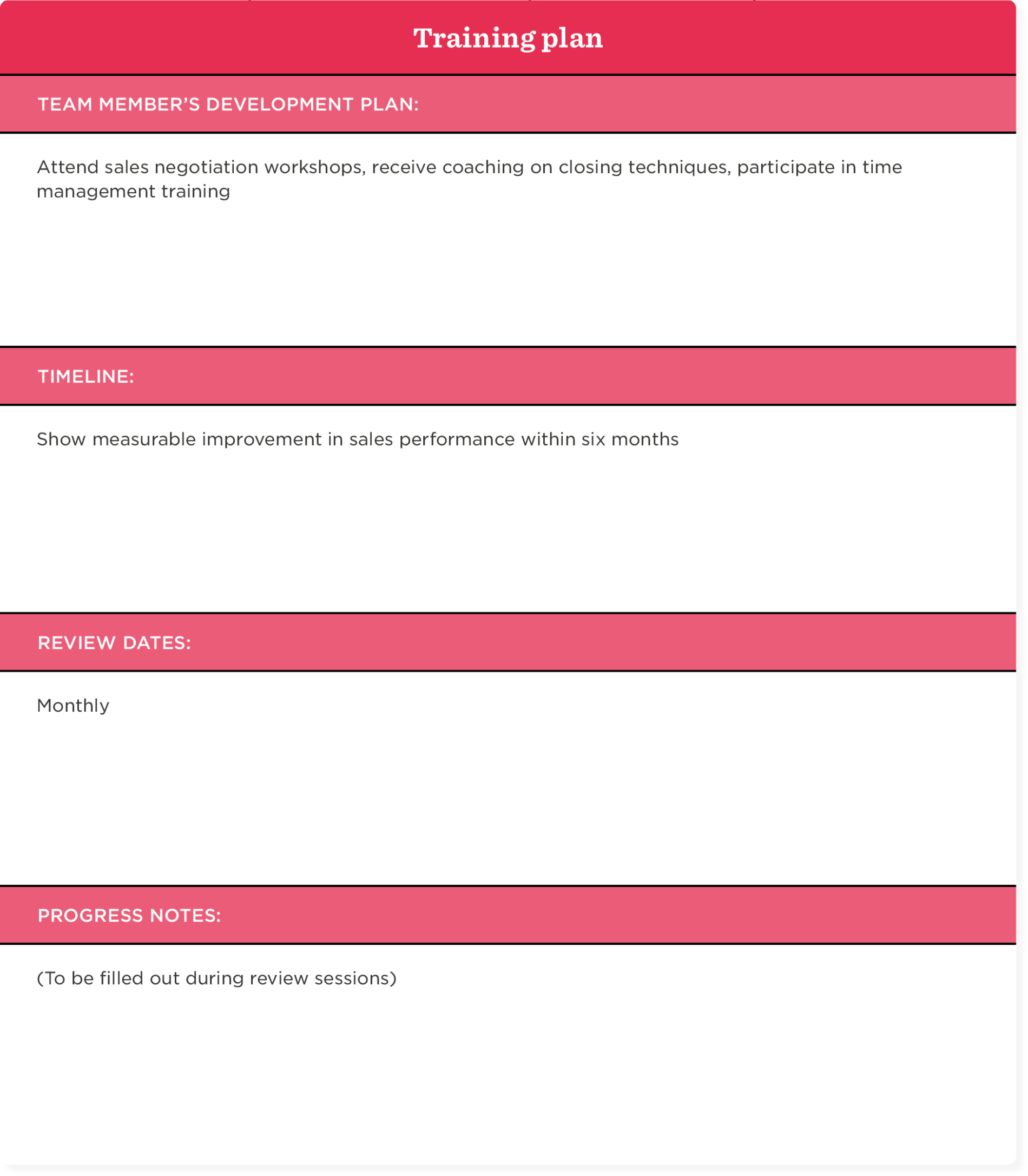
Implementing your employee development plans
Creating your employee development plans is a vital first step, but the journey doesn’t stop there. The next challenge is implementing your plans and enabling actual progress and change within your team.
Here are some detailed steps to help bring your EDPs into reality:
- Communicate clearly and continuously. As with any business interaction, clear communication is crucial. When team members fully understand their development plans, agree with the goals set, and fully commit to pursuing them, they are more likely to stay motivated and make meaningful progress. Communication is a two-way street, and allowing team members to express any concerns or provide general feedback allows them to be heard. You can encourage this by holding regular meetings and providing open communication channels.
- Provide full support. Supporting your team members comes in many forms, all of which are vital for growth. Support can include ensuring there’s enough budget for training, each team member has the time they need to work on their goals, and everyone has full access to mentors and coaches.
- Monitor progress. Your job isn’t over when the plans are complete. In fact, tracking your team members’ journeys is just as important as actually setting up the plans themselves. Regular check-ins or progress meetings can help reinforce the importance of their goals and provide an opportunity to discuss challenges, give feedback, and even celebrate successes.
- Foster a constructive environment. We all know how vital a good company culture is. But when it comes to EDPs, a culture that encourages, recognizes, and rewards learning and development can significantly enhance its effectiveness. This also includes promoting collaboration, knowledge-sharing, and nurturing curiosity and creativity. Most importantly, supportive environments motivate your team and amplify their learning experiences.
Leveraging HR tech in employee development plans
Modern HR tech has revolutionized the way that organizations can create, track, support, and refine their employee development plans. With the help of these tools, creating your EDPs can become a seamless, data-driven process.
Here are four key benefits of integrating HR tech into your development planning:
- Real-time progress tracking. HR tech allows you to monitor the progress of each of your EDPs in real time. This helps make sure that goals are on track, timelines are adhered to, and adjustments are made as needed.
- Personalized development plans. With data-driven insights gleaned from your HR tech, you can deliver tailored plans to meet the specific needs, goals, and strengths of your people—helping make each plan more personalized and effective.
- Centralized resources and communication. HR tech helps centralize training materials, feedback, and communication, ensuring everyone involved in the development process has easy access to the resources they need.
- Data-driven decision-making. By providing valuable analytics, HR tech helps leaders assess the effectiveness of development plans, enabling informed decisions and continuous improvement.
Recommended For Further Reading
Measuring development plans’ success
To make sure your employee development plans deliver what you planned, it’s important to continually measure their effectiveness. Here are three key points to consider when evaluating the success of your EDPs:
- Key performance indicators (KPIs): In your plan, set clear and measurable KPIs that link to each goal or objective in your team member’s EDP. These KPIs could be anything that shows progress toward their end goals—such as projects completed, sales targets, customer satisfaction scores, or other metrics.
- Feedback scores: During your regular feedback sessions with team members, ask them to evaluate and score how effective they feel their plans are. This feedback can help you tweak your plans to keep them as effective as possible. You can also gather feedback from team members’ managers or team leaders.
- Objectives achieved: Review whether or not your people have successfully met the objectives and goals set out in the EDPs. This includes the improvements your team members have made in their general performance or any other aspects of career progression. Identify any places where you can see that they’ve successfully met their objectives, or made substantial progress, indicating that the plans have been successful.
Plan for your team members’ success
Employee development plans are a powerful tool that can drive individual growth, the employee experience, and organizational success.
By investing time, care, and resources in your team’s development, you’re nurturing your most valuable asset,your people. And when your people shine, your organization shines too.
Use our free templates to jump-start your own employee development plans—helping you, your organization, and your team pave the way for a brighter, more productive future.

